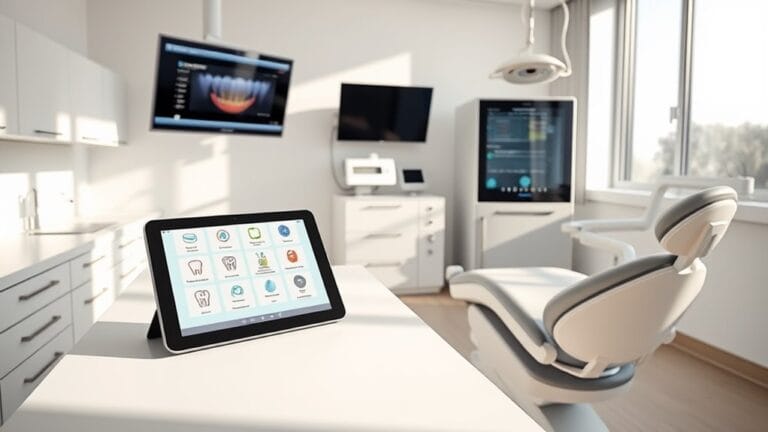Smart Scheduling Transforms Patient Management Workflow
You might not realize that nearly 30% of scheduled medical appointments result in no-shows, which greatly disrupts patient management workflows. Smart scheduling technology can change that by automating and optimizing appointment allocation, but its benefits extend far beyond just reducing missed visits. As you explore how this approach enhances operational efficiency and patient engagement, you'll uncover strategies that not only streamline processes but also elevate the overall quality of care delivered in healthcare settings. If you're looking for assistance in implementing these solutions, feel free to contact us. We can connect you with experts who can provide tailored solutions to improve your patient management. What you find may reshape your perspective on patient management.
Importance of Smart Scheduling
Smart scheduling is essential in today's healthcare environment, where demands on physician capacity and patient access are ever-increasing. By leveraging intelligent scheduling tools, you can optimize physician capacity, filling available appointment slots according to their preferences. This approach considerably reduces the financial burden associated with patient cancellations and no-shows, which cost the industry a staggering $150 billion annually.
Moreover, utilizing these data-driven decisions can lead to a 5-10% increase in physician utilization, particularly among specialties like Gastroenterology, Orthopedic, and Urology, which achieve impressive utilization rates of 87-98%. Automated wait-list management enhances overall capacity by backfilling canceled appointments, ensuring that every slot is maximized. Additionally, data-driven insights from scheduling tools can inform operational improvements, further refining the scheduling process.
In addition to improving capacity, smart scheduling enhances patient engagement. Online self-scheduling empowers patients to book appointments at their convenience, reducing administrative burdens and increasing satisfaction. Up to 32% of appointments are made outside business hours, demonstrating a clear demand for flexibility.
Reducing Errors and Protocol Deviations
Implementing automated scheduling processes can greatly reduce errors and protocol deviations in patient management. By integrating these systems with Electronic Medical Records (EMR) and Electronic Health Records (EHR), the need for manual data entry is eliminated, greatly enhancing error reduction. Advanced software takes into account crucial factors such as provider preferences and visit reasons to create accurate schedules, which directly supports protocol compliance. Automated reminders for upcoming visits further improve adherence to timelines, minimizing no-shows and contributing to a more efficient workflow.
With centralized management, you can easily coordinate schedules, identify issues, and assign caregivers based on their availability and skills. Self-scheduling and waitlists help fill gaps in the schedule, ensuring effective resource utilization. Moreover, automated validation settings flag data-entry errors, allowing for real-time updates and notifications that keep everyone informed about scheduling changes. By fostering efficient communication and oversight, your team can quickly address inconsistencies, ensuring that every step aligns with protocols. Additionally, the complexity of scheduling increases with the number of items considered during scheduling, underscoring the importance of automation in managing these challenges.
This strategic approach not only enhances patient care but also fortifies the integrity of clinical trials, leading to better outcomes for all involved.
Optimizing Resources Effectively
Effective resource optimization in patient management hinges on leveraging advanced software solutions that automate scheduling processes. By using sophisticated scheduling algorithms, you can evaluate crucial factors like care continuity, staff availability, and individual skill sets. This not only streamlines resource allocation but also enhances care delivery, guaranteeing that each patient receives timely attention from the right professionals. Additionally, maintaining continuity of care ensures that patients build trust with their caregivers, leading to improved health outcomes.
To optimize resources effectively, conducting thorough needs assessments is fundamental. Analyzing historical data and understanding patient demand helps you predict future needs, allowing for proactive adjustments in staffing. Identifying specific resource requirements guarantees that you allocate personnel efficiently, particularly during peak service times.
Standardizing scheduling protocols is equally important. Clear, consistent guidelines reduce confusion among staff and foster better communication. Centralized scheduling systems enhance coordination, enabling you to prioritize urgent cases and utilize resources to their fullest potential.
Lastly, fostering efficient communication among your team is crucial. By understanding the skill sets and preferences of your healthcare professionals, you can balance workloads and minimize burnout. This strategic approach not only optimizes resource allocation but also cultivates a harmonious work environment, ultimately benefiting patient care.
Enhancing Patient Flow Control
In today's healthcare environment, enhancing patient flow control is vital for delivering timely and efficient care. By implementing online appointment systems, you can streamline admissions and reduce wait times, which ultimately enhances patient convenience.
Utilizing advanced data analytics allows you to forecast patient demand patterns, ensuring that you match capacity with demand effectively. A system-wide approach helps hospitals manage the complexities of patient flow more effectively.
Integrating quality improvement and Lean management techniques can further optimize admissions, while applying Production Planning, Scheduling and Control (PPSC) concepts helps clarify "what," "how much," "when," and "where" to deliver care.
A well-organized triage system is essential for evaluating the severity of patients' conditions, allowing you to prioritize care based on urgency and reduce unnecessary delays.
Creating a dedicated patient flow team fosters communication among departments, enhancing flow coordination throughout the patient journey.
Implementing queue management systems and sharing waiting-list information can mitigate bottlenecks and improve operational efficiency.
Finally, leveraging technology such as smart patient flow modeling systems and remote monitoring of patient health can greatly enhance patient navigation, ensuring that care shifts are smooth and effective.
Improving Patient Experience
Enhancing patient flow control lays the groundwork for improving the overall patient experience. By implementing effortless appointment booking, you empower patients to manage their schedules with ease. With 77% of patients considering online booking vital, integrating systems that allow 24/7 access to appointment availability increases patient engagement and satisfaction metrics. Additionally, the use of automated email and text notifications keeps patients informed on updates and appointments, further enhancing their experience.
Personalized communication and reminders further enhance the experience. Automated notifications reduce no-shows, while tailored reminders help patients stay on track. By actively seeking feedback through surveys, you not only gather valuable insights but also demonstrate that patient opinions matter, fostering a culture of continuous improvement.
Reducing waiting times is essential. Efficient scheduling and telehealth options provide alternatives, ensuring patients spend less time waiting and more time receiving care. Digital check-in systems streamline processes, while intelligent scheduling algorithms optimize resource utilization, balancing patient demand effectively.
Valuing patient feedback allows for real-time adjustments in care delivery, ensuring that treatment plans align with individual needs and preferences.
Automation for Increased Efficiency
Automation has the potential to revolutionize healthcare efficiency, with studies showing that it can reduce administrative workloads by up to 30%. By streamlining administrative tasks like billing, appointment scheduling, and medical records management, you can considerably cut down on time spent on repetitive workflows. This not only minimizes paperwork but also enhances data accuracy, allowing healthcare providers to make better-informed clinical decisions.
Moreover, intelligent scheduling systems optimize resource allocation, ensuring that staff workloads are balanced effectively. This predictive capability allows for adjustments in staffing during patient flow peaks, reducing stress and improving overall productivity. Additionally, the healthcare automation market is projected to reach $42.24 billion by 2024, indicating the growing importance and investment in these technologies.
Automated systems can also identify and rectify data errors swiftly, which is vital for compliance and avoiding costly mistakes.
As you implement these automated solutions, you'll likely notice a marked reduction in staff burnout. By alleviating the administrative burdens, your team can focus more on what truly matters—providing exceptional patient care.
Ultimately, embracing automation in your healthcare workflow can lead to improved efficiency, enhanced patient experiences, and a healthier work environment for your staff.
Standardizing Workflow Processes
Building on the efficiencies gained through automation, standardizing workflow processes becomes a key strategy for further improvement in patient management. By creating a master list of call types and categorizing them, you simplify management and enhance workflow consistency. This reduces fragmentation and allows your team to focus on standardized call types, improving overall patient care.
Workflow documentation is critical here; outlining detailed workflows for each call type guarantees that all agents follow a uniform approach. Using a standard format for documentation makes it easy to skim and follow, reducing the risk of unintended outcomes. Additionally, analyzing frequency of call types helps prioritize which issues need more immediate attention, ensuring that the most common patient inquiries are addressed efficiently.
Implementing process mapping serves as the foundation for training and accountability, limiting process variation and enhancing quality and cost efficiency. Additionally, limiting agent choices to just a few options streamlines decision-making. This aligns with Lean methodology principles, eliminating waste and prioritizing urgent tasks.
Consolidating tools and technologies further boosts your workflows, reducing redundancy and improving interoperability. By focusing on these strategies, you not only elevate the efficiency of your operations but also greatly enhance the patient experience, guaranteeing that every interaction is meaningful and effective.
Future of Patient Management Automation
The future of patient management automation promises to revolutionize how healthcare providers interact with patients and streamline administrative processes. AI advancements will play a vital role, utilizing predictive analytics to anticipate patient needs and optimize scheduling, ultimately enhancing patient engagement. Automation can streamline up to 33% of daily tasks in healthcare, making it crucial for practices to embrace these technologies.
By integrating intelligent scheduling solutions, you'll notice a significant reduction in wait times and improved resource allocation, fostering better provider collaboration. As automation becomes more prevalent, addressing automation challenges will be essential. You'll need to guarantee that data security remains a top priority, especially as blockchain technology and hyper-automation techniques enhance data integrity and sharing.
Future trends indicate that automated systems won't only manage routine tasks but also provide personalized communication, sending tailored health reminders and educational content to patients. Moreover, the integration of advanced Natural Language Processing (NLP) will streamline documentation, creating accurate electronic health records. This seamless workflow integration will empower your staff to focus on complex tasks, ultimately improving patient outcomes.
Frequently Asked Questions
How Does Smart Scheduling Impact Staff Morale and Productivity?
Smart scheduling boosts staff engagement by optimizing workflow efficiency. When you have control over your schedules, it reduces stress and promotes balance, leading to enhanced morale and productivity, ultimately benefiting both you and your organization.
What Training Is Required for Staff to Use Smart Scheduling Systems?
To master system usability, you'll need extensive training, typically lasting several sessions. Focus on automated scheduling, data analysis, compliance, and user adoption strategies, ensuring you're fully equipped to enhance efficiency and serve your team effectively.
Are There Any Costs Associated With Implementing Smart Scheduling Solutions?
Yes, implementing smart scheduling solutions involves various implementation expenses, such as development, integration, and compliance costs. Conducting a cost benefit analysis helps you evaluate potential savings and improved efficiency against these initial investments.
How Secure Is Patient Data in Smart Scheduling Systems?
Patient data security in smart scheduling systems relies on robust data encryption, stringent access controls, strong user authentication, and thorough audit trails, ensuring compliance with privacy regulations and maintaining high standards for data protection.
Can Smart Scheduling Be Integrated With Existing Healthcare Software?
You might think integrating smart scheduling with existing healthcare software is a breeze, but compatibility issues can pose significant challenges. However, overcoming these hurdles enhances efficiency, streamlining processes to better serve your patients' needs.
Conclusion
To sum up, embracing smart scheduling isn't just about technology; it's about enhancing patient care and operational efficiency. While you might have concerns about the initial setup, keep in mind that the long-term benefits—like reduced errors and improved patient satisfaction—far outweigh the temporary adjustments. By automating scheduling, you can streamline workflows and focus more on what truly matters: delivering high-quality care.
As the healthcare landscape evolves, smart scheduling will become an essential tool in effective patient management. If you're feeling overwhelmed or uncertain about implementing these changes, don't hesitate to reach out to us for assistance. Our expert help can save you time, reduce stress, and significantly improve your dental practice. We're here to support you in making the most of smart scheduling to enhance your patient management workflow.





